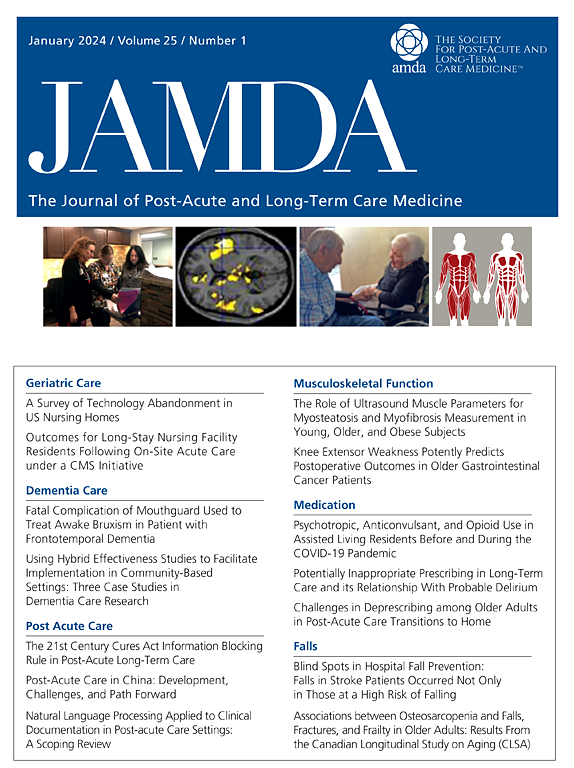Associations between Digital Skill, eHealth Literacy, and Frailty among Older Adults: Evidence from China
IF 4.2
2区 医学
Q2 GERIATRICS & GERONTOLOGY
Journal of the American Medical Directors Association
Pub Date : 2024-09-19
DOI:10.1016/j.jamda.2024.105275
引用次数: 0
Abstract
Objectives
Frailty is a common geriatric syndrome in older adults; however, its relationship with digital factors is underexplored. This study aimed to examine the association between digital skills, eHealth literacy, and frailty to provide insights for developing frailty interventions in the digital age.
Design
Cross-sectional study.
Setting and Participants
Data were collected from a cross-sectional survey of older adults aged ≥60 years in China.
Methods
We used a digital skills questionnaire, the eHealth Literacy Scale, and the Tilburg Frailty Indicator to measure digital skill, eHealth literacy, and frailty, respectively. Linear regression and logistic models were established to explore the association between digital skill, eHealth literacy, and frailty. Finally, we used a structural equation model and the Karlson-Holm-Breen method to test the mediation.
Results
A total of 2144 older adults were included in this study. The rates of adequate digital skill, adequate eHealth literacy, and frailty were 4.1%, 11.9%, and 38.3%, respectively. Digital skill (β = −0.108; 95% CI, −0.151 to –0.065) and eHealth literacy (β = −0.153; 95% CI, −0.195 to –0.112) were negatively associated with frailty score (P < .05), and adequate digital skill (odds ratio, 0.367; 95% CI, 0.170-0.793) and adequate eHealth literacy (odds ratio, 0.455; 95% CI, 0.298-0.694) were associated with a lower prevalence of frailty. eHealth literacy had a mediating effect on the association between digital skills and frailty.
Conclusions and Implications
Better digital skill and eHealth literacy are associated with a lower prevalence of frailty among older adults. The association between digital skill and frailty was found to be completely mediated by eHealth literacy.
老年人数字技能、电子健康素养与虚弱之间的关系:来自中国的证据
目的:虚弱是老年人常见的老年综合症,但其与数字因素的关系却未得到充分研究。本研究旨在探讨数字技能、电子健康素养与虚弱之间的关系,为在数字时代制定虚弱干预措施提供见解:设计:横断面研究:数据来自于对中国≥60 岁老年人的横断面调查:我们使用数字技能问卷、电子健康素养量表和蒂尔堡虚弱指标分别测量数字技能、电子健康素养和虚弱。建立线性回归和逻辑模型来探讨数字技能、电子健康素养和虚弱之间的关联。最后,我们使用结构方程模型和卡尔森-霍尔姆-布林方法检验了中介作用:本研究共纳入了 2144 名老年人。充分的数字技能、充分的电子健康素养和虚弱的比例分别为 4.1%、11.9% 和 38.3%。数字技能(β = -0.108; 95% CI, -0.151 to -0.065)和电子健康素养(β = -0.153; 95% CI, -0.195 to -0.112)与虚弱评分呈负相关(P < .05),充分的数字技能(几率比,0.367; 95% CI, 0.170-0.电子健康素养对数字技能与虚弱之间的关联具有中介作用:较好的数字技能和电子健康素养与老年人较低的虚弱患病率有关。数字技能与虚弱之间的关系完全受电子健康素养的影响。
本文章由计算机程序翻译,如有差异,请以英文原文为准。
求助全文
约1分钟内获得全文
求助全文
来源期刊
CiteScore
11.10
自引率
6.60%
发文量
472
审稿时长
44 days
期刊介绍:
JAMDA, the official journal of AMDA - The Society for Post-Acute and Long-Term Care Medicine, is a leading peer-reviewed publication that offers practical information and research geared towards healthcare professionals in the post-acute and long-term care fields. It is also a valuable resource for policy-makers, organizational leaders, educators, and advocates.
The journal provides essential information for various healthcare professionals such as medical directors, attending physicians, nurses, consultant pharmacists, geriatric psychiatrists, nurse practitioners, physician assistants, physical and occupational therapists, social workers, and others involved in providing, overseeing, and promoting quality

 求助内容:
求助内容: 应助结果提醒方式:
应助结果提醒方式:


